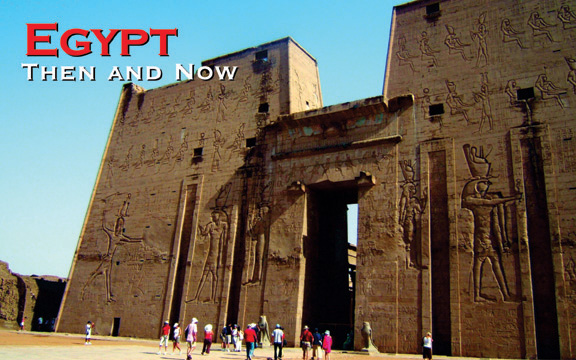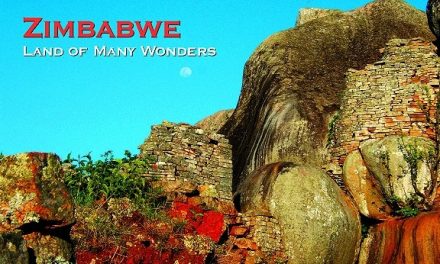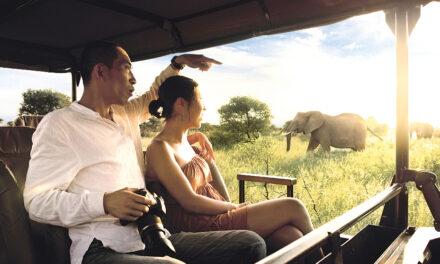Egypt
Then and Now
Published in the Winter 2005-06 Issue of Canadian World Traveller
Text and Photos: Michael Morcos
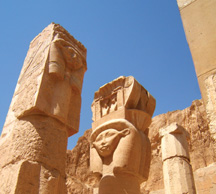 On our arrival at Cairo’s International Airport at 3 a.m., we drove to our hotel, which overlooked the legendary Nile River. Over the years, this fabled capital city had grown in population to over 18 million inhabitants, becoming the largest city in Africa. Today, new buildings vie for space with historic monuments in this ever-expanding, dynamic city. Greater Cairo now stretches out on both banks of the Nile as far as the eye can see.
On our arrival at Cairo’s International Airport at 3 a.m., we drove to our hotel, which overlooked the legendary Nile River. Over the years, this fabled capital city had grown in population to over 18 million inhabitants, becoming the largest city in Africa. Today, new buildings vie for space with historic monuments in this ever-expanding, dynamic city. Greater Cairo now stretches out on both banks of the Nile as far as the eye can see.
But I had brought my wife and teenaged son and daughter from Canada to experience all of Egypt, the land of my birth, so we left this teeming city the next day to visit the ancient archaeological sites of Saqqara and Giza, located on the West Bank of the Nile.
Saqqara
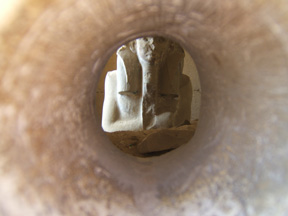
The impressive, wind-eroded Step Pyramid, located in Saqqara, was built for King Djoser (Dynasty 3). This is the first known monumental structure made of stone anywhere in the world. As its name suggests, the pyramid is formed by a series of six levels of stone, decreasing in size as they ascend to about 60 meters in height. In its vicinity, local farmers and shepherds worked the land with their oxen, buffalos and donkeys, seemingly oblivious of their historic surroundings.
The Giza Plateau
We then travelled a short distance north to the Giza to see he Great Pyramids and the mysterious Sphinx.
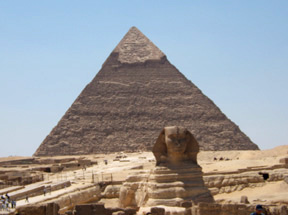 The spectacular Pyramid of Khufu (c.2585-2560 B.C.) is the largest of the three principal pyramids on the Plateau. It reaches 137.2 meters in height. The Pyramid of Khafre (c.2555-2532 B.C.) is 136.5 meters in height. Near its summit, it still retains some of its original smooth limestone veneer that once clad the entire structure. The Pyramid of Menkaure (c.2532-2510 B.C.) completes this astounding trio.
The spectacular Pyramid of Khufu (c.2585-2560 B.C.) is the largest of the three principal pyramids on the Plateau. It reaches 137.2 meters in height. The Pyramid of Khafre (c.2555-2532 B.C.) is 136.5 meters in height. Near its summit, it still retains some of its original smooth limestone veneer that once clad the entire structure. The Pyramid of Menkaure (c.2532-2510 B.C.) completes this astounding trio.
Climbing these pyramids, one realises how huge the stones and the actual structures are. What a feat of engineering it must have been then, as it would be even today! After walking around the pyramids, we approached the world-famous Sphinx. No one knows its true age, but when the legs of the Sphinx reach out to envelope its visitors, while its majestic head towers above, the effect is quite breathtaking.
Back to Cairo
We had a busy day back in Cairo. It was very hot and humid in the city when we visited the Cairo Museum with its impressive King Tut exhibit. After a refreshing dip in the hotel’s pool to wash away our accumulated sweat, we visited Cairo’s newest shopping mall, which matches any North American mall. Thankfully it was air-conditioned! It was big, brightly lit, and crowded with shoppers, but the mostly imported merchandise on display was quite expensive. We wondered how the locals could afford to shop there!
Mohammad Ali Mosque
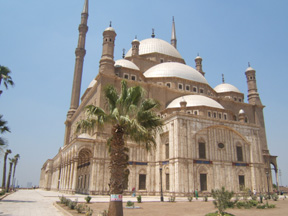
The next day, we visited the ornate Mohammad Ali Mosque (also known as the Alabaster Mosque), which was begun in 1830 and finished in 1857. Mohammad Ali Pasha, built it in the Ottoman style.
From the arcaded courtyard, we had a magnificent view across the city to the pyramids at Giza. In addition, the lookout from its Ottoman style dome, which soars to 50 metres, offers a dramatic, 360-degree panoramic view of Cairo.
Khan El Khalili Bazaar
We lunched at a street café, which featured great cheap food. It cost us just five Canadian dollars for our family of four!
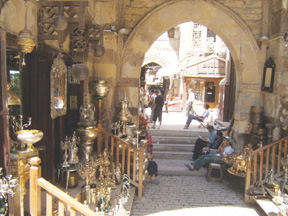 After lunch, we wandered through the Khan El Khalili Bazaar, one of the most interesting bazaars, not only in Egypt but also in the entire Middle East. It was named after Prince Jaharkas Al Khalili, who was one of the powerful Mamluke princes in the 14th century. It is famous for its unusual oriental souvenirs, typical handmade crafts and entertaining vendors.
After lunch, we wandered through the Khan El Khalili Bazaar, one of the most interesting bazaars, not only in Egypt but also in the entire Middle East. It was named after Prince Jaharkas Al Khalili, who was one of the powerful Mamluke princes in the 14th century. It is famous for its unusual oriental souvenirs, typical handmade crafts and entertaining vendors.
The Medieval atmospheres of this traditional market, together with the labyrinth layout of its streets, gave us a glimpse into what medieval markets were like.
Aswan
That night, we boarded a night train for the 926 km journey south along the Nile to Aswan. It was a pleasant, air-conditioned ride, with onboard meals served with our choice of beer and wine, and comfortable sleeping berths.
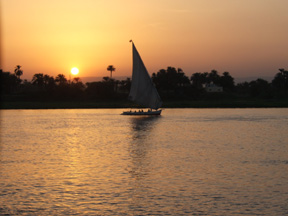
When we arrived the next morning, it was already 35 degrees Celsius, which climbed to 43 degrees in the afternoon! We took a refreshing boat ride on a Felucca, the traditional Egyptian graceful sailboat found all along the Nile. That night, we visited a local Souk (outdoor marketplace), which was smelly, noisy and dirty… but we loved it for its authenticity! And what was that meat hanging from those hooks? We didn’t dare to ask!
Next morning, we visited the Aswan High Dam, which controls the flow of water to avoid flooding along a great part of the Nile. This huge, rock-filled dam created one of the world’s largest reservoirs, Lake Nasser. The dam, known as Saad el Aali in Arabic, was completed in 1970 after 18 years of work.
Defying the hot, hot weather we experienced in Aswan, we toured the Philae Temple, which has the last known hieroglyphic inscriptions in Egypt, dating from 394 AD. The hieroglyphs are crude in execution but are clear enough to read.
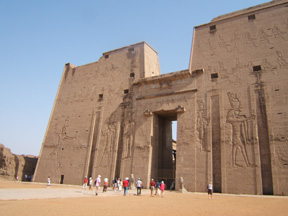
A Cruise Down the Nile
After lunch, we boarded our boat for a cruise down the Nile north to Luxor. Our first stop was at Kom Ombo, This is the site of a Ptolemaic temple, built in the early second century B.C. to pay homage to the crocodile-headed god Sobek and the falcon god Haroeris (HoArus the Elder). Being a popular stop for many of the Nile’s cruise boats, the site was crowded with tourists.
We continued down the Nile to Edfu (our mooring for the night). Its Temple of Horus has a massive entrance pylon covered with sunk-relief carvings. This Ptolemaic temple was constructed between 237 and 57 B.C. But the highlight of our stop was witnessing a local wedding party proceeding along the streets of the town, accompanied by local musicians. At one point, the party stopped in the middle of the main street of the town to celebrate.
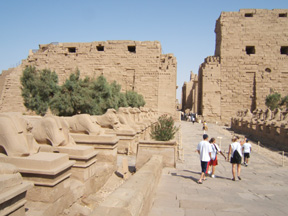
The next morning, we continued on our cruise to Luxor through the locks at Esna. The scenery along this section on the Nile was incredible. Lush vegetation hugged its banks while sand dudes of the Sahara Desert encroached right behind it. Along the banks, local kids swam and waved at the passing boats and cows grazed under the watchful eyes of their owners.
Luxor
At Luxor, we left our boat early in the morning to visit the incomparable and almost overwhelming Valley of the Kings. Among the must-sees are the Avenue of the Sphinxes, its stone sentinels combining the bodies of lions with the head of Nectanebo I (380-363 B.C.); Luxor Temple itself and its principal entrance, the Pylon of Ramesses II (c.1279-1213 B.C.), which is flanked by two seated statues of the king; and the impressive Court of Ramesses II (c.1279-1213 B.C.) with its colonnade of closed papyrus-bud columns.
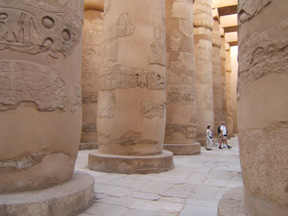 We also visited the Temples of Thebes with its sphinxes that combine the bodies of lions with the heads of rams; The Temple of Amun at Karnak and its colossal columns; and The Great Hypostyle Hall of Karnak Temple, which was begun during the reign of King Sety I (c.1290-1279 B.C.) and was finally completed by his son, Ramesses II (c.1279-1213 B.C.).
We also visited the Temples of Thebes with its sphinxes that combine the bodies of lions with the heads of rams; The Temple of Amun at Karnak and its colossal columns; and The Great Hypostyle Hall of Karnak Temple, which was begun during the reign of King Sety I (c.1290-1279 B.C.) and was finally completed by his son, Ramesses II (c.1279-1213 B.C.).
What a day it had been! We had absorbed thousands of years of history in just a few days. That night, we had drinks with the friends we had met on the boat who hailed from around the world and said our fond farewells.
Sham el-Sheikh
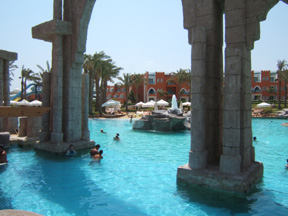
The next day we toke a flight from Luxor’s airport across the Red Sea to Sham el-Sheikh, Egypt’s best known and most visited beach resort on the Sinai Peninsula. Talk about a change of pace! In just over an hour we were checking into a resort hotel with seven pools and a fabulous beach for three days of pampered and well-earned rest and relaxation.
However, in my exuberance at being able to snorkel in the crystal-clear waters of the Red Sea, surrounded by colourful schools of tropical fish, I managed to badly scrape my legs on the sharp coral rocks! Even this mishap couldn’t spoil what was a great experience.
Our next leg of our journey would take us by bus to Cairo to catch a train to Alexandria, Egypt’s second largest city.
A Desert Adventure
The bus ride back to Cairo from the Sinai proved to be quite an adventure! The police stopped the bus twice for security checks, the first time for passports and IDs and the second to check our baggage for explosives with trained sniffing dogs, before allowing the bus to enter the tunnel under the Red Sea that would take it back to the African mainland.
However, the bus ride proved interesting in another unexpected way. Along the route, we occasionally caught sight of wild camels and oil pumps in the desolate desert landscape. These chance sightings proved to be welcome distractions from the very bad Arab language movies that were being shown on the bus!
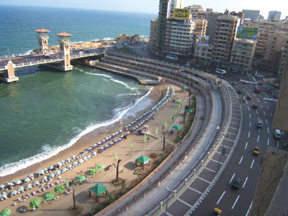
Alexandria
After our transfer to a train in Cairo, we finally were on our way to Alexandria. Around 330 B.C., Alexander the Great ordered the Greek architect Dinocrates to build this Mediterranean port city. It quickly flourished into a prominent cultural, intellectual, political, and economic metropolis, the remains of which are evident even to this very day.
Our accommodations were on one of the upper floors of a beachfront apartment. The cool breezes of the Mediterranean Sea constantly wafted into our room and the view of the sea and the bridge that was built across the small cove in front of our highrise building was spectacular, especially when the bridge was illuminated at night.
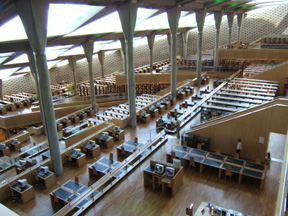
We visited the Bibliotheca Alexandria, a stunning new edifice inaugurated in 2001 on the city’s waterfront. It is both a commemoration of the original Library of Alexandria that was lost in antiquity and the world’s fourth largest present-day library. We also spent a relaxing afternoon at the extensive Montazah Palace Gardens, which were once the private royal gardens of King Faruk, the last king of Egypt. Today it’s a beautiful public park full of palm trees, pines and flowers and the site of exclusive hotels.
That night, we had supper at a seaside Greek restaurant that consisted of fish caught on the very same day and cooked to our liking. What a truly fantastic Mediterranean meal! We then went to the shopping area of the city at 11 p.m. and found it packed shoulder to shoulder for miles!
An Early Morning Dip
The next morning, I got up early and went for a swim in the warm, clear waters of the Mediterranean. The waves were quite strong but invigorating. I was enjoying my temporary solitary swim, as I knew the crowds would soon arrive to claim the beach.
I knew that our idyllic sojourn in this pearl of the Mediterranean was ending and it was time for us to return to Cairo to spend a couple of days with family and friends who lived there and shop for souvenirs to bring back to Canada.
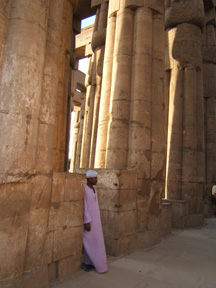 As we got on to our return flight to Montreal with our dark tans, sun-bleached hair and a lifetime of memories, we all agreed that our family tour of ancient and modern Egypt had been a smashing success in every way.
As we got on to our return flight to Montreal with our dark tans, sun-bleached hair and a lifetime of memories, we all agreed that our family tour of ancient and modern Egypt had been a smashing success in every way.
For More Info:
Egyptian Tourist Authority in Canada
2020 University, Suite 2260
Montréal, QC H3A 2A5
Tel.: 514-861-4200
Fax: 514-861-8071
Email: info.ca@egypt.travel
Official Website: www.egypt.travel

